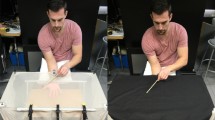Abstract
Whether right- and left-handedness are defined as a function of individual tasks or represent general categories across tasks has been long debated. However, the literature on handedness primarily concerns industrialized societies in which manual work has been extensively automated, and the majority of individuals in those countries do not use their arms and hands intensively for highly specialized tasks on an everyday basis. Thus, the question remains whether results from those countries regarding handedness are transferable to countries where the majority of individuals are still exploiting their lateralized skills. Here, we sampled 506 individuals from 143 locations on the islands of Flores and Adonara, Indonesia, to assess their hand preference for and hand performance on several tasks in order to evaluate, in a non-industrialized country, the level of manual specialization and the relevance of right- or left-handedness as general categories. Generalized-declared handedness was consistent with task-declared handedness across 10 specific tasks and with a measure of strength and a measure of skilfulness, suggesting that general handedness is a valid concept. This hand specialization for tasks is discussed in the context of intense and daily tool use in this agricultural society.


Similar content being viewed by others
References
Annett M (1970) A classification of hand preference by association analysis. Br J Psychol 61:303–321. https://doi.org/10.1111/j.2044-8295.1970.tb01248.x
Bryden MP (1977) Measuring handedness with questionnaires. Neuropsychologia 15:617–624. https://doi.org/10.1016/0028-3932(77)90067-7
Carrière S, Raymond M (2000) Handedness and aggressive behavior in an Ntumu village in southern Cameroon. Acta Ethologica 2:111–114
Cavanagh T, Berbesque JC, Wood B, Marlowe F (2016) Hadza handedness: lateralized behaviors in a contemporary hunter–gatherer population. Evol Hum Behav 37:202–209. https://doi.org/10.1016/j.evolhumbehav.2015.11.002
Cavill S, Bryden P (2003) Development of handedness: comparison of questionnaire and performance-based measures of preference. Brain Cogn 53:149–151. https://doi.org/10.1016/S0278-2626(03)00098-8
Chau N, Petry D, Bourgkard E, Huguenin P, Remy E, Andre JM (1997) Comparison between estimates of hand volume and hand strengths with sex and age with and without anthropometric data in healthy working people. Eur J Epidemiol 13:309–316. https://doi.org/10.1023/A:1007308719731
Cochet H, Byrne RW (2013) Evolutionary origins of human handedness: evaluating contrasting hypotheses. Anim Cogn 16:531–542. https://doi.org/10.1007/s10071-013-0626-y
Connolly KJ, Bishop DVM (1992) The measurement of handedness: a cross-cultural comparison of samples from England and Papua New Guinea. Neuropsychologia 30:13–26. https://doi.org/10.1016/0028-3932(92)90010-J
Corballis MC, Hattie J, Fletcher R (2008) Handedness and intellectual achievement: an even-handed look. Neuropsychologia 46(1):374–378. https://doi.org/10.1016/j.neuropsychologia.2007.09.009
Coren S, Porac C (1978) The validity and reliability of self-report items for the measurement of lateral preference. Br J Psychol 69:207–211. https://doi.org/10.1111/j.2044-8295.1978.tb01649.x
Dellatolas G, Tubert P, Castresana A, Mesbah M, Giallonardo T, Lazaratou H, Lellouch J (1991) Age and cohort effect in adult handedness. Neuropsychologia 29:225–261. https://doi.org/10.1016/0028-3932(91)90086-N
Edlin JE, Leppanen ML, Fain RJ, Hackländer RP, Hanaver-Torrez SD, Lyle KB (2015) On the use (and misuse?) of the Edinburgh handedness inventory. Brain Cogn 94:44–51. https://doi.org/10.1016/j.bandc.2015.01.003
Faurie C, Raymond M (2005) Handedness, homicide and negative frequency-dependent selection. Proc R Soc B Biol Sci 272(1558):25–28
Faurie C, Schiefenhoevel W, leBomin S, Billiard S, Raymond M (2005) Variation in the frequency of left-handedness in traditional societies. Curr Anthropol 46:142–147. https://doi.org/10.1086/427101
Fleiss JL (1971) Measuring nominal scale agreement among many raters. Psychol Bull 76:378–382. https://doi.org/10.1037/h0031619
Gilbert AN, Wysocki CJ (1992) Hand preference and age in the United States. Neuropsychologia 30:601–608. https://doi.org/10.1016/0028-3932(92)90065-T
Goldstein SR, Young CA (1996) “Evolutionary” stable strategy of handedness in major league baseball. J Comp Psychol 110:164–169. https://doi.org/10.1037/0735-7036.110.2.164
Grice KO, Vogel KA, Le V, Mitchell A, Muniz S, Vollmer MA (2003) Adult norms for a commercially available Nine Hole Peg Test for finger dexterity. Am J Occup Ther 57:570–573. https://doi.org/10.5014/ajot.57.5.570
Gritsenko V, Hardesty R, Boots MT, Yakovenko S (2016) Biomechanical constraints underlying motor primitives derived from the musculoskeletal anatomy of the human arm. PLoS One 11:1–18. 18p. https://doi.org/10.1371/journal.pone.0164050
Günther CM, Bürger A, Rickert M, Crispin A, Schulz CU (2008) Grip strength in healthy Caucasian adults: reference values. J Hand Surg 33:558–565. https://doi.org/10.1016/j.jhsa.2008.01.008
Incel NA, Ceceli E, Durukan PB, Erdem HR, Yorgancioglu ZR (2002) Grip strength: effect of hand dominance. Singap Med J 43:234–237 Retrieved from: http://www.ncbi.nlm.nih.gov/pubmed/12188074
Innes E (1999) Handgrip strength testing: a review of the literature. Aust Occup Ther J 46:120–140. https://doi.org/10.1046/j.1440–1630.1999.00182.x
Llaurens V, Raymond M, Faurie C (2009) Why are some people left-handed? An evolutionary perspective. Phil Trans R Soc B 364:881–894. https://doi.org/10.1098/rstb.2008.0235
Malina RM (2004) Secular trends in growth, maturation and physical performance: a review. Anthropol Rev 67:3–31 Retrieved from: http://anthro.amu.edu.pl/pdf/paar/vol067/01malina.pdf
Marchant LF, McGrew WC (1998) Human handedness: an ethological perspective. Hum Evol 13:221–228. https://doi.org/10.1007/BF02436506
Marchant LF, McGrew WC (2013) Handedness is more than laterality: lessons from chimpanzees. Ann N Y Acad Sci 1288:1–8. https://doi.org/10.1111/nyas.12062
Marchant LF, McGrew WC, Eibl-Eibesfeldt I (1995) Is human handedness universal? Ethological analyses from three traditional cultures. Ethology 101:239–258. https://doi.org/10.1111/j.1439-0310.1995.tb00362.x
Mathiowetz V, Kashman N, Volland G, Weber K, Dowe M (1985) A grip and pinch strength normative data for adults. Arch Phys Med Rehabil 66:254–262 Retrieved from: http://bleng.com/media/wysiwyg/Mathiowetz_Grip_and_Pinch_Strength_Norms.pdf
McManus IC (1996) Handedness. In: Beaumont JG, Kenealy PM, Rogers MJC (eds) The Blackwell dictionary of neuropsychlogy. Blackwell, Oxford, pp 367–376
Millencovic S, Dragovic M (2012) Modification of the Edinburgh handedness inventory: a replication study. Laterality 18:340–348. https://doi.org/10.1080/1357650X.2012.683196
Mitsionis G, Pakos EE, Stafilas KS, Paschos N, Papakostas T, Beris AE (2009) Normative data on hand grip strength in a Greek adult population. Int Orthop 33:713–717. https://doi.org/10.1007/s00264-008-0551-x
Moliner-Urdiales D, Ruiz JR, Ortega FB, Jiménez-Pavón D, Vicente-Rodriguez G, Rey-López JP et al (2010) Secular trends in health-related physical fitness in Spanish adolescents: the AVENA and HELENA studies. J Sci Med Sport 13:584–588. https://doi.org/10.1016/j.jsams.2010.03.004
Napier JR (1956) The prehensile movements of the human hand. J Bone Joint Surg 38:902–913 Retrieved from: http://www.bjj.boneandjoint.org.uk/content/jbjsbr/38B/4/902.full.pdf
Oldfield RC (1971) The assessment and analysis of handedness: the Edinburgh inventory. Neuropsychologia 9:97–113. https://doi.org/10.1016/0028-3932(71)90067-4
Peters M (1998) Description and validation of a flexible and broadly usable handedness questionnaire. Laterality 3(1):77–96. https://doi.org/10.1080/713754291
Raczkowski D, Kalat JW, Nebes R (1974) Reliability and validity of some handedness questionnaire items. Neuropsychologia 12:43–47. https://doi.org/10.1016/0028-3932(74)90025-6
Rife DC (1940) Handedness, with special reference to twins. Genetic 25:178–186 Retrieved from: http://www.genetics.org/content/genetics/25/2/178.full.pdf
Salmaso D, Longoni AM (1985) Problems in the assessment of hand preference. Cortex 21:533–549. https://doi.org/10.1016/S0010-9452(58)80003-9
Schaafsma SM, Geuze RH, Riedstra B, Schiefenhövel W, Bouma A, Groothuis TGG (2012) Handedness in a nonindustrial society challenges the fighting hypothesis as an evolutionary explanation for left-handedness. Evol Hum Behav 33:94–99. https://doi.org/10.1016/j.evolhumbehav.2011.06.001
Silverman IW (2011) The secular trend for grip strength in Canada and the United States. J Sports Sci 29:599–606. https://doi.org/10.1080/02640414.2010.547209
Steele J, Uomini N (2005) Humans, tools, and handedness. In: Roux V, Bril B (eds) Stone knapping: the necessary conditions for a uniquely Hominin behaviour. McDonald Institute for Archaeological Research, Cambridge, pp 217–239
Werle S, Goldhahn J, Drerup S, Simmen BR, Sprott H, Herren B (2009) Age- and gender-specific normative data of grip and pinch strength in a healthy adult Swiss population. J Hand Surg 34:76–84. https://doi.org/10.1177/1753193408096763
Wood CJ, Aggleton JP (1989) Handedness in ‘fast ball’ sports: do lefthanders have an innate advantage? Br J Psychol 80:227–240. https://doi.org/10.1111/j.20448295.1989.tb02316.x
Acknowledgements
We are very grateful to Valérie Durand for bibliographic help and to the Program Magister Menuju Doktor untuk Sarjana Unggul (PMDSU) 2015 for providing funding to BS. This is contribution ISEM 2017-229 SUD of the Institute of Evolutionary Science of Montpellier.
Author information
Authors and Affiliations
Corresponding author
Electronic supplementary material

Figure S1
Starting position of the peg-moving task. A board of and English version of the peg solitaire game is used, with two sets of three pegs with different colours. Tweezers (depicted) are used to move the pegs. A first move (arrow 1) is to jump a brown peg orthogonally over an adjacent red peg into a hole two positions away. The other arrows depict the four other moves of one row. The total number of moves of a trial is thus 5 × 3. A second trial is done with the other hand, and this process is repeated three times. (JPEG 42 kb)
Table S1.
(TXT 51 kb)
Rights and permissions
About this article
Cite this article
Nurhayu, W., Nila, S., Raymond, M. et al. Are right- and left-handedness relevant as general categories in a non-industrialized country?. acta ethol 21, 21–28 (2018). https://doi.org/10.1007/s10211-017-0279-y
Received:
Revised:
Accepted:
Published:
Issue Date:
DOI: https://doi.org/10.1007/s10211-017-0279-y




